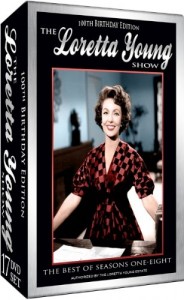 The Loretta Young Show, which aired on NBC from 1953 to 1961, embodies a lot of TV history. First of all, it’s an anthology series, a format which is completely dead on current television, in which a different, self-contained story is told in each episode, with some kind of through-line. The Twilight Zone was a spooky anthology, Playhouse 90 usually featured an adaptation of a hit play, and The Loretta Young Show did what no other TV show in the early ’50s, anthology or otherwise was doing: telling dramatic stories from a woman’s point of view.
The Loretta Young Show, which aired on NBC from 1953 to 1961, embodies a lot of TV history. First of all, it’s an anthology series, a format which is completely dead on current television, in which a different, self-contained story is told in each episode, with some kind of through-line. The Twilight Zone was a spooky anthology, Playhouse 90 usually featured an adaptation of a hit play, and The Loretta Young Show did what no other TV show in the early ’50s, anthology or otherwise was doing: telling dramatic stories from a woman’s point of view.
That’s probably what attracted Young to the show, initially called Letter From Loretta, in the first place—this show marks the first time a major Hollywood movie star crossed over into the still young, still novel, and still second-rate medium of TV. Young won an Oscar in 1947 for The Farmer’s Daughter, was nominated for another in 1949, and in 1953, publicly announced her retirement from film to host an anthology series for the fledgling NBC. (She kept her word—she never starred in another film.)
Young injected big-screen charisma and glamour to the small-screen. The framing device of the show was Young reading a letter from a woman that would introduce that night’s episode, which could be a light romance, a melodrama, or a tragedy. At the story’s end, she’d return to the screen with a famous quote or a Bible passage (also something you don’t see on TV anymore) to cap the episode. These bookends are the most famous element of The Loretta Young Show—because Young would grandly emerge from a doorway wearing an elaborate, movie-star quality evening gown, more often than not designed by top designer Jean Louis (who she would later marry, in 1990, at age 93).
It’s because of those dresses that you don’t see the show much in syndicated reruns, and why if you really want to enjoy an overlooked TV classic, the monster, 17-disc, The Loretta Young Show: 100th Birthday Edition set is a good addition to the library. In 1966, Young sued NBC for allowing stations to air reruns of the show with her bookends—contractually they were supposed to cut those, as Young feared constantly airing images of her in old dresses would make the dresses, and the actress herself, look outdated and outmoded. (She won.)
This mammoth, days-long collection is approved by Young’s estate. Frankly, in the age of tape-wiping, it’s amazing that this many episodes of the show are even still in existence. But there’s plenty of room for extras, including interviews with Young’s children, one with Young herself (who died in 2000), and some home movies. But the real gems are the episodes themselves, truly a lost classic from a lost genre.





Comments